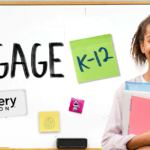By Marty Creel
In my current role as Discovery Education’s Chief Academic Officer, I’ve had the opportunity to learn about different nations’ educational systems as I’ve worked with our network of partners worldwide. This wonderful experience has shaped my belief that the United States’ education system, when judged on the totality of its mission, is among the greatest public service initiatives in history.
However, that is not to say that our system is not without its issues. When it comes to the challenges American education faces, I tend to agree with the position of Karen Cator, President and CEO of Digital Promise, who, in a 2014 blog post, stated, “The problem with education in America is not lack of excellence. It’s lack of equity.” Despite the tremendous flexibility and innovative spirit American educators display each day as they meet the needs of their increasingly diverse learners, as Cator states, equity is a critical issue we must overcome.
At Discovery Education, we have a strong sense of duty to the mission of improving equity within our education system. Likewise, we feel that digital content can be a tremendous asset in this effort.
However, not all digital content is equal. While the internet is awash in free digital content purported to be appropriate for classroom use, we believe standards-aligned High Quality Digital Content (HQDC) specifically developed for diverse student audiences and curated by experts for ease of access is among the most powerful resources available to school systems seeking to improve equity. Some of the key characteristics of HQDC are:
The Ability to Improve the Vocabulary of the Youngest Learners
The gap between students from high socioeconomic backgrounds and those impacted by poverty begins early. It’s well known that students entering pre-school from dual-income families with higher education levels have much deeper and more extensive spoken vocabularies than those who do not. Students who speak a different language at home and encounter academic English for the first time in the classroom must jump yet another hurdle. HQDC provides the youngest students exposure to a wide variety of school-oriented language. Whether it is through video that comes in dual languages, or digital text that can be read aloud through digital readers, early access to HQDC helps our youngest learners close the vocabulary gap.
The Ability to Break Down Barriers to Learning for All Students
Once students enter school, HQDC provides learners multiple pathways to understanding. The basic goal of Universal Design for Learning (UDL) is to provide students as many ways as possible to learn, so that the various barriers to understanding can be overcome. HQDC is unique in that there is almost always another pathway to learning immediately available. Beginning with a graphically attractive visual design, students are naturally drawn into the material. If a student stumbles on the meaning of a word, well-designed HQDC provides alternative explanations. If they struggle with reading fluency, HQDC provides a read aloud options. If the text is too complex, HQDC provides a lower level of complexity. If reading the text did not engage them, there is a video alternative, or better yet, an interactive tool to help them understand the concept. HQDC also provides multiple language options for students learning a second language.
The Ability to Provide All Students Multiple Ways to Shine
The other main goal of UDL is to provide students many ways to demonstrate what they have learned. Rather than sticking to one-size-fits-all assignments, UDL encourages educators to let students show what they have learned in many different manners, from the traditional written response to a complex video production. HQDC resources should include simple opportunities for written responses, as well as rubrics and exemplary responses that give students examples and goals. In addition, HQDC must have structures in place that encourage the feedback loops between teachers and students and students and their peers. Most importantly, well-constructed HQDC provides students alternative venues for showing their understanding through a variety of mediums, such as simple graphical presentation, digital drawing, or quick self-produced video.
The Ability to Engage All Students in High-Level Thinking
While digital content alone does not help students transition to higher level thinking, HQDC that is expertly curated to ensures more student engagement, which then results in richer thought. Whether it is a virtual reality experience, an information graphic, or a favorite video clip, HQDC deploys assets that make students want to read a passage, analyze data, solve a problem, or discuss a topic to learn more. Creating this type of learning ecosystem requires instructional architects who know the materials available to them and understand the pathways that help students reach high level standards. The architects of HQDC design educational content that works together, which ultimately saves teachers the considerable amount of time it takes to plan instruction that engages all in higher level thinking and learning.
At Discovery Education, we put a premium on creating HQDC, because we believe it has the capacity to support our collective struggle to improve equity. We encourage our peers throughout the education services sector to do their part to improve equity by designing, building, and implementing HQDC that meet these criteria. Today’s media-savvy students demand and deserve nothing less.
With over 26 years of experience as an educator, Marty Creel leads Discovery Education’s innovative Digital Instruction Group. Marty began his career as an engaging social studies teacher known for creatively using technology to deepen learning. As a district-wide curriculum, instruction, and professional development leader in a large urban/suburban school system, he was the architect of a thoughtful transition to instructional standards that empowered teachers and principals to support the success of each learner. He may be reached at marty_creel@discovery.com or found on Twitter @creelmar.
The American Consortium for Equity in Education, publisher of the "Equity & Access" journal, celebrates and connects the educators, associations, community partners and industry leaders who are working to solve problems and create a more equitable environment for historically underserved pre K-12 students throughout the United States.
- American Consortium for Equity in Educationhttps://ace-ed.org/author/admin/
- American Consortium for Equity in Educationhttps://ace-ed.org/author/admin/April 23, 2025
- American Consortium for Equity in Educationhttps://ace-ed.org/author/admin/
- American Consortium for Equity in Educationhttps://ace-ed.org/author/admin/







